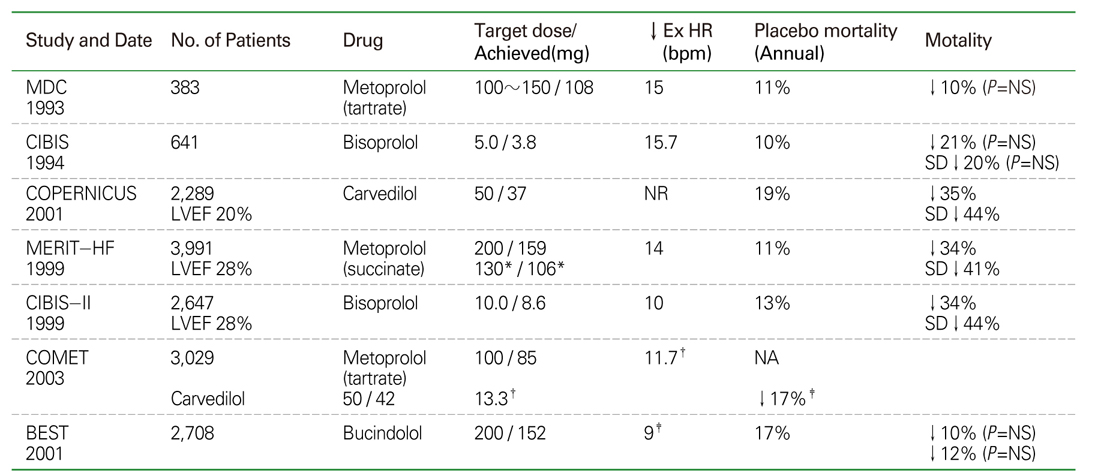 |
 |
- Search
| J Korean Med Assoc > Volume 50(3); 2007 > Article |
Abstract
References
Figure 1

Table 1

Differences are statistically significant unless otherwise indicated
Abbreviations: Ex HR, exercise heart rate; LVEF, left ventricular ejection fraction; NA, not applicable; NS, not statistically significant; SD, sudden death
*Approximate equivalence of metoprolol titrate
†Decrease in mean heart rate (not exercise heart rate)
‡Difference compared with metoprolol
MDC=Metoprolol in dilated cardiomyopathy
CIBIS=Cardiac insufficiency bisoprolol study
COPERNICUS=The carvedilol prospective randomized cumulative survival trial
MERIT-HF=The metoprolol CR / XL randomised intervention trial in congestive heart failure
COMET=Commentary on the carvedilol or metoprolol European trial
BEST=Beta-blocker evaluation of survival trial
Table 3

*Beta receptors are the average of data from radiological binding data in myocardial membranes and recombinant receptors, and inhibition in functional assays; alpha1 receptors are from myocardial membranes. Metoprolol and bisoprolol data are from radiological binding data in myocardial membranes. Nebivolol data are from another laboratory, in guinea pig receptor preparations
†K(Beta1) = average of high-affinity dissociation constant determined from 125I-CYP competition curves in human ventricular myocardial membranes, dissociation constant determined from competition curves in transfected cells expressing recombinant human beta1 receptors, and dissociation constant determined from inhibition of isoproterenol-mediated stimulation of muscle contraction in preparations of nonfailing human heart.
K(Beta2) = average of low-affinity dissociation constant determined from 125I-CYP competition curves, dissociation constant determined from simple curve fitting in transfected cells expressing recombinant human beta2 receptors, and dissociation constant determined from inhibition of isoproterenol-mediated stimulation of adenyl cyclase in membrane preparations of human heart.
K(Alpha1) = dissociation constant determined from 125I-BE2254 competition curves in human ventricular myocardial membranes
‡Based on an alpha1 K1 of 69 nM in human saphenous vein ring segments
- TOOLS
-
METRICS

-
- 0 Crossref
- Scopus
- 1,234 View
- 6 Download
-
Related articles in
J Korean Med Assoc -
Treatment of advanced heart failure2022 January;65(1)
Device treatment of heart failure2022 January;65(1)
Update on the Treatment of Hepatocelluar Carcinoma1997 February;40(2)
Recent Trend in Treatment of Atopic Dermatitis1997 March;40(3)
Recent Trend in Treatment of Allergic Rhinitis1997 March;40(3)






